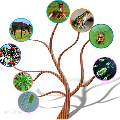Web search is among the most frequent online activities. Whereas traditional information retrieval techniques focus on the information need behind a user query, previous work has shown that user behaviour and interaction can provide important signals for understanding the underlying intent of a search mission. An established taxonomy distinguishes between transactional, navigational and informational search missions, where in particular the latter involve a learning goal, i.e. the intent to acquire knowledge about a particular topic. We introduce a supervised approach for classifying online search missions into either of these categories by utilising a range of features obtained from the user interactions during an online search mission. Applying our model to a dataset of real-world query logs, we show that search missions can be categorised with an average F1 score of 63% and accuracy of 69%, while performance on informational and navigational missions is particularly promising (F1>75%). This suggests the potential to utilise such supervised classification during online search to better facilitate retrieval and ranking as well as to improve affiliated services, such as targeted online ads.
翻译:传统的信息检索技术侧重于用户查询背后的信息需求,而先前的工作则表明,用户行为和互动可以提供重要信号,以了解搜索任务的基本意图。既定的分类学区分交易、导航和信息搜索任务,特别是后者涉及学习目标,即获取特定主题知识的意图。我们采用一种监督办法,利用在线搜索任务期间用户互动取得的一系列特征,将在线搜索任务分为其中任一类别。将我们的模型应用于真实世界查询日志数据集,我们表明搜索任务可以分类为平均F1分63%和准确度69%,而信息和导航任务的业绩特别有希望(F1>75%)。这表明在网上搜索中利用这种监督分类的潜力,以更好地进行检索和排序,并改进相关服务,例如有针对性的在线广告。




